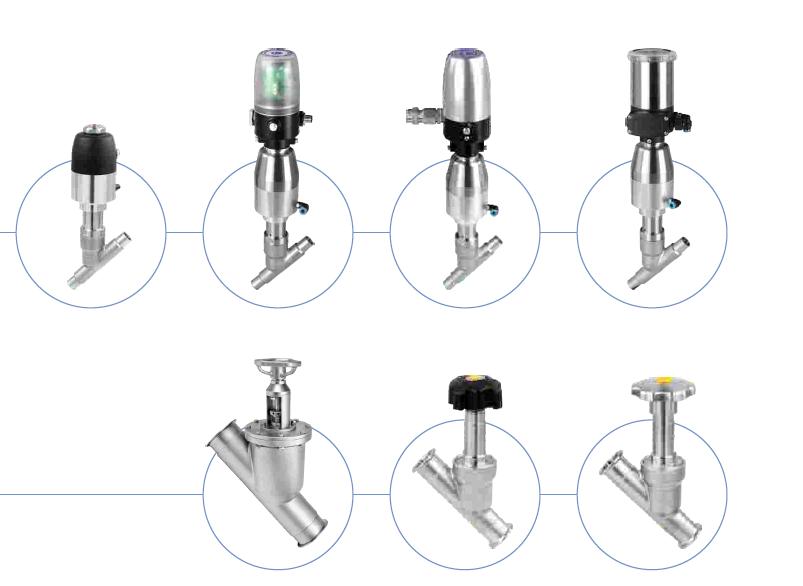 15 Tue 2025
15 Tue 2025
In industries such as pharmaceutical, food and beverage, and biotechnology, troubleshooting and solutions for sanitary angle seat valves are essential to maintain their hygienic integrity and operating efficiency.
1. Aging of Seals:
Cause: Normal or premature wear of seals due to excessive operating frequency, high pressure, or high temperature.
Solution: Replace the seals, making sure to use the correct material for your application (e.g. PTFE, EPDM), and follow the manufacturer's instructions for proper installation and compression to achieve a tight seal without over-tightening.
2. Actuator Problems:
Cause: Low air pressure, faulty solenoid valve, or damaged actuator.
Solution: Make sure the actuator is getting the correct air pressure, check the function of the solenoid valve, and check the actuator for any physical damage.
3. Reduced Flow:
Cause: Internal blockage in the valve, the valve size is not suitable for the application, or the valve seat is damaged.
Solution: Check for any blockage, verify the flow of the valve, and ensure the valve size is appropriate.
3. Leakage of Stem Packing:
Cause: Worn stem packing, causing leakage around the stem.
Solution: Replace the stem packing with a compatible material.
4. Inconsistent operation:
Cause: Control system problem, such as a three-way solenoid valve, or incorrect actuator settings.
Solution: Check that the solenoid valve is operating properly and make sure the actuator is adjusted correctly.
5. Internal leakage (fluid passing through when the valve is closed):
Symptom: Fluid continues to flow or drip (commonly referred to as "passing through") even when the valve is in the fully closed position.
Cause: Worn or damaged disc seal/seat: The soft seal on the disc (valve plug) or the sealing surface inside the valve body (seat) may be worn, corroded, scratched, or otherwise damaged.
Solution: Isolate and bleed the valve. Disassemble the valve and carefully inspect the sealing surfaces of the disc/spindle and seat. Replace the disc seal (usually an O-ring or flat seal) or replace the entire disc/spindle if the seal is one-piece. If the seat inside the valve body is damaged, more extensive repairs or valve replacement may be required.
6. Foreign matter/debris on the valve seat:
Cause: Small particles (such as welding slag, scale, product residue, detergent sediment) are stuck between the valve disc and the valve seat, resulting in incomplete sealing.
Solution: When safe, try to use the system flow cycle to open and close the valve several times to flush out the debris. If the problem persists, isolate, drain and disassemble the valve for manual cleaning and inspection. If the debris problem recurs, ensure that the upstream filtration is effective.
7. The valve cannot be fully opened/closed or is stuck:
Symptoms: The valve cannot move to the commanded open or closed position, moves slowly or is stuck.
Cause: Insufficient air source pressure, solenoid valve failure, actuator damage, valve stem stuck, seal aging and expansion.
Solution: Check whether the air source pressure meets the requirements, test whether the solenoid valve is working properly, check whether the actuator mechanism has air leakage, disassemble the valve body to check whether the valve stem moves smoothly, and finally replace the aged sealant.

1. Regular inspection:
Regularly check for leaks, abnormal noises and whether it works properly.
2. Correct installation:
Make sure the valve is installed correctly and follows the correct flow and direction.
3. Lubrication maintenance:
If applicable, lubricate moving parts according to the manufacturer's recommendations.
4. Preventive maintenance:
Schedule routine maintenance and replace worn parts to prevent major problems.
5. Cleaning and disinfection
Clean even after use to avoid media residue and use cleaning agents that meet hygiene standards.
By following these troubleshooting steps and implementing preventive maintenance measures, the service life of the sanitary angle seat valve can be effectively extended to ensure the hygienic safety and stable and efficient operation of the production process.
Why sanitary stainless steel butterfly valves corrosion resistant?